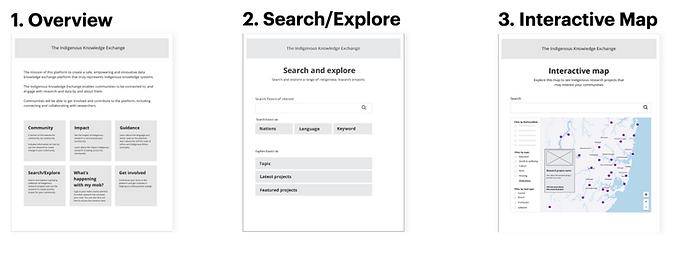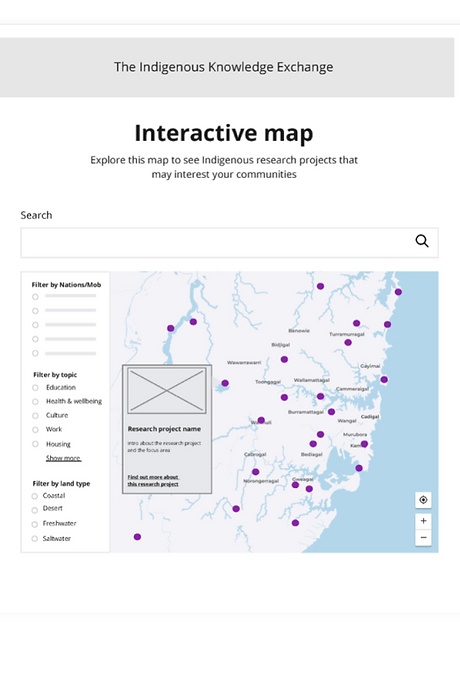
AIATSIS
"Empowering Indigenous Knowledge Through Digital Access"
Company: Australian Institute of Aboriginal and Torres Strait Islander Studies
Project Name: AIATSIS
Indigenous Knowledge Exchange platform.
Roles and Duration:
UX Research, Strategy & UI design
Dec 2022 - Mar 2023
In collaboration with Alex...
About AIATSIS
AIATSIS (Australian Institute of Aboriginal and Torres Strait Islander Studies) is a national organisation that commissions and supports research to strengthen cultural understanding and inform policy development for Aboriginal and Torres Strait Islander communities.
Our brief: design an experience that empowers researchers, policymakers, and Indigenous communities to access, share, and connect with Indigenous knowledge — ethically and meaningfully. It will take into consideration Indigenous story telling techniques and the differences in documenting information.
Challenge
AIATSIS manages decades of research across thousands of projects, but much of this information lived in disconnected systems.
Users — from policy teams to Indigenous communities — struggled to find and engage with content relevant to their needs.
The challenge was to:
-
Build a central digital exchange for Indigenous research and knowledge.
-
Make it inclusive, transparent, and accessible across diverse audiences.
-
Balance government-grade data systems with community-first values.
Research & Discovery
We began by mapping out the ecosystem of users:
-
Policy Makers – using research to guide decisions.
-
Researchers – contributing to national projects.
-
Community Groups – engaging with cultural or social programs.
-
Community Members – seeking stories, guidance, or connection.
7 participants identified as members of an Indigenous community.
Sessions combined interviews and low-fidelity concept testing to explore themes of accessibility, trust, and collaboration.

Insights & Opportunity
Our key opportunity was clear:
Create a digital platform that bridges research, policy, and community through shared access to Indigenous knowledge.
Key insights:
-
Accessibility was inconsistent across user groups.
-
Ethical representation and data sovereignty were critical.
-
Community members needed visibility and ownership of stories. Cultural safety was important considering the history of government bodies.
-
Researchers wanted structured, searchable archives.


Validating initial visual concepts
To validate early assumptions and test the usability of low-fidelity concepts representing how communities, researchers, and policymakers would interact with the Indigenous Knowledge Exchange platform.


Overview page
Focus: Introduced the mission and core sections — Community, Impact, Guidance, Search/Explore, Get Involved, What’s Happening With My Mob.
Feedback:
-
Seen as welcoming, clear, and culturally appropriate.
-
The “What’s happening with my mob?” feature resonated deeply as an inclusive and engaging entry point for Indigenous users.
-
Reinforced the importance of community and impact content to make the platform feel relevant and empowering.
Insight:
Supporting resources under Community and Impact sections significantly increase value and trust.

Search & Explore
Focus: Users could explore research by Nation, Language, or Keyword and filter results by Topic or Latest Projects.
Feedback:
-
Highly valued by participants for its flexibility and relevance.
-
Searching by Mob or Country helped users see their identity reflected.
-
Policymakers appreciated topic filtering for research alignment (e.g. justice, youth wellbeing).
Insight:
Enable multi-path searching that supports both policy and community discovery.

Interactive Map
Focus: A map-based interface for discovering Indigenous research projects by location and topic.
Feedback:
-
The most well-received feature — intuitive, engaging, and accessible.
-
Helped users visualize the spread of research and identify underrepresented regions.
-
Researchers and community members valued the connection between place and research (“land type” filters were especially useful).
-
Seen as a bridge for those who prefer visual navigation over text search.
Quotes:
“It would show past and present research — that’s what the community wants to see.”
“Visuals are easier to read than charts full of information.”
“It helps you discover things you might not know about through keywords alone.”
Insight:
The map created a sense of connection to Country and positioned research as living knowledge tied to land.

Research Projects
Focus
This concept explored how individual research projects could be presented within the platform — highlighting context, outcomes, and impact rather than dense academic detail.
The goal was to make research understandable and relatable for community members, policymakers, and researchers alike, while reinforcing transparency and accessibility.
Feedback
-
Participants valued having a clear project overview paired with story-driven context instead of long technical summaries.
-
The section successfully communicated the “why” behind each project, helping users connect emotionally to the purpose and outcomes of the research.
-
Policy shapers and community representatives both wanted to see project impact — how findings are being used or benefiting communities.
-
The layout encouraged curiosity and made research feel approachable and purposeful.
Quotes
“I like the impact — it’d be nice to see what the outcome is.” — Policy Shaper
“I’m always big on context — to understand what it’s all about, that’s the overview and story about the project.” — Community Group Data Manager
Insight
A storytelling-led presentation of research creates emotional connection and understanding.
By surfacing project outcomes and human stories, the platform bridges the gap between data and lived experience, turning research from information into impactful, community-relevant knowledge.

Guidance & Ethics
Focus:
This concept tested how AIATSIS could offer accessible, actionable ethical guidance — including the AIATSIS Code of Ethics, Indigenous data principles, and best-practice resources.
Feedback:
-
Participants strongly supported a centralised ethics and guidance hub, noting its importance for promoting cultural safety and research integrity.
-
The inclusion of a simplified, visual version of the ethics code was seen as particularly valuable for accessibility and understanding.
-
The feature positioned AIATSIS as a national authority on Indigenous research standards, helping educate and align all stakeholders around shared ethical principles.
Quotes:
“AIATSIS Code of Ethics — it’d be great to have a simplified version that’s easy to access.”
“This helps people grasp ethical frameworks quickly and apply them to real projects.”
Insight:
By simplifying and curating ethical resources, AIATSIS can lead by example, strengthening trust, accountability, and quality across Indigenous research — ensuring that ethics become an enabler of connection, not a barrier to participation.

Get involved
Focus:
The Get Involved concept explored ways for community members and researchers to actively participate in the platform — by contributing stories, suggesting projects, and collaborating on shared topics of interest.
Feedback:
-
Participants saw this as a highly engaging and empowering feature, allowing community voices to shape future research directions.
-
Policymakers found it valuable for gaining first-hand understanding of community priorities, especially when designing or evaluating programs.
-
The feature was praised for fostering connection, dialogue, and inclusion, moving beyond a passive data portal toward a living exchange platform.
Quotes:
“It’s a great way for community members to contribute their stories and deepen understanding.”
“This helps bridge the gap between researchers and community needs.”
Insight:
Encouraging contribution builds trust and shared ownership, positioning the platform as a collaborative ecosystem that amplifies Indigenous voices and ensures research outcomes are community-driven.

Value proposition
Focus:
The Knowledge Exchange Platform empowers users to easily discover and engage with Indigenous research and knowledge from any device.
Feedback:
Participants valued its accessibility, reliability, and collaborative nature, highlighting its potential as a central hub for ethically sourced Indigenous research and community-curated knowledge.
The interactive map and project insights were praised for making research exploration intuitive and transparent.
Quotes (from themes):
“It’s great to have one trusted place for Indigenous research that’s community-driven.”
“The ability to search and explore easily makes the research feel more alive and useful.”
Insight:
By combining trusted curation, ethical design, and user-friendly access, the platform bridges researchers, policymakers, and communities — positioning AIATSIS as the national leader in digitally connecting and preserving Indigenous knowledge through transparency, impact, and collaboration.


